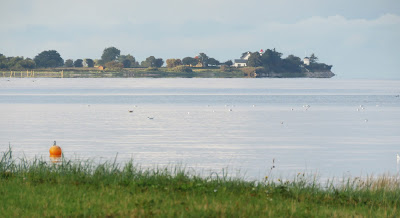Sep 22, 2017
South tip of Langeland, Denmark, September 15, 2017
We are two dedicated, hikers working for the extension of the Archipelago trail to include beautiful South Langeland. We have therefore given ourselves the task of describing a hiking route from where it presently so abrupt ends today (Lindelse Nor), via Skovsgård Manor til Bagenkop. We hiked and taken notes and pictures along the way so we have a description ready. We hope that our proposal for a route can help to speed up the difficult process of the extension of the Archipelago trail. And we have experienced some beautiful hikes with many beautiful views of Langeland, the coast and the sea and many good experiences. The pictures here are from the last stage of our project: The walk along the coast from the east of Broløkke Manor around the southern tip / Keldsnor Lighthouse to Bagenkop.
Øbjerg, just east of the Langelandsfort (http://www.langelandsfortet.dk/), seen from the north
View from Øbjerg to the north
Two young (at least at hearth) fishermen on their way to the sea
Starting the outboard motor
The staircase down to the beach from the forest Lunden
View from the Danish Nature Agency’s hiking trail in Lunden
Primitive camp sites in Lunden (http://eng.naturstyrelsen.dk/experience-nature/sleeping-outside-in-nature/)
View from Lunden
Just after Lunden we came to Keldsnor Lighthouse
View of Keldsnor
The Dunlins in Keldsnor get a powernap in the strong wind
Grey plovers in Keldsnor
View north along the spite between Keldsnor and Langelandsbæltet
When we came to Vesterskov, the good weather had ended. View towards Bredstensbjerg
Just north of Bagenkop
9 September, 2017, South of Spodsbjerg, Langeland; DK
A quiet late afternoon south of Spodsbjerg
The ferry from Langeland to Lolland
Comorant get-together
Langelandsbæltet
European greenfinch
View towards Tranekær Lighthouse
Red admiral butterfly.
3 September, 2017, Opening ceremony in the Medical Gardens, Tranekaer. Langeland, Denmark
The opening ceremony took place in garden 5, the garden for herbs for the treatment of diseases involving nervous system and movement apparatus.
In the Medicine Gardens in Tranekær there are about 500 different plants, and by them all there are signs that tell of the previous and present medical use effects of the plants. The gardens are open all year from sunrise to sunset (www.medicinhaverne.dk, www.facebook.com/medicinhaverne). The main focus Medicine Gardens is the cultural history of the use of plants in medicine.
Helle Ravn, the chairwoman of the Medical Gardens, holds the opening speech
Helle Ravn and Count Christian Ahlefeldt-Laurvig
Count Christian is struggling to cut the steel wire
The garden for herbs for the treatment of diseases involving nervous system and movement apparatus are officially opened
A little refreshment to the guests (homemade!)
Dam in the garden for nervous system and movement apparatus
One of the permanent residents of the garden, a green frog, is attentive to the opening ceremony
Saturday, August 26, 2017, Langeland, Denmark
A walk along the east coast of Langeland.
There is no official hiking trail along the southern part of the east coast of Langeland, and it attracts very few visitors even though it is very beautiful. For historical and political reasons, the present hiking trail on Langeland (Øhavsstien – Hiking along the Archipelago) only covers the northern and central part of the island.
The east coast of Langeland has a straight coastline. Waves and currents has rearranged the coast to make it straight. Behind this straight coastline there has previously been a number of wetlands. Today, the wetlands are transformed into grain fields by means of ditches and pumping stations.
The east coast of Langeland has a straight coastline because waves and currents have moved material around.
White wagtail
White wagtail
Cormorants: Wherever there is a row of fishing stakes for fixed nets along the coast of Langeland, you will find a cormorant sitting on each stake.
Common sandpiper
Subscribe to:
Comments (Atom)







































